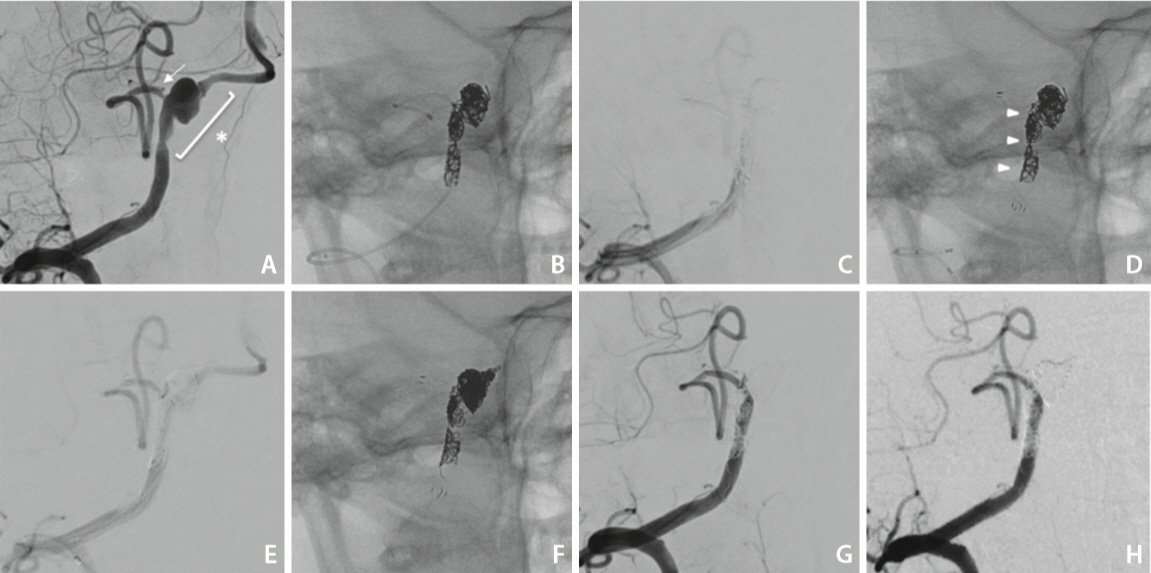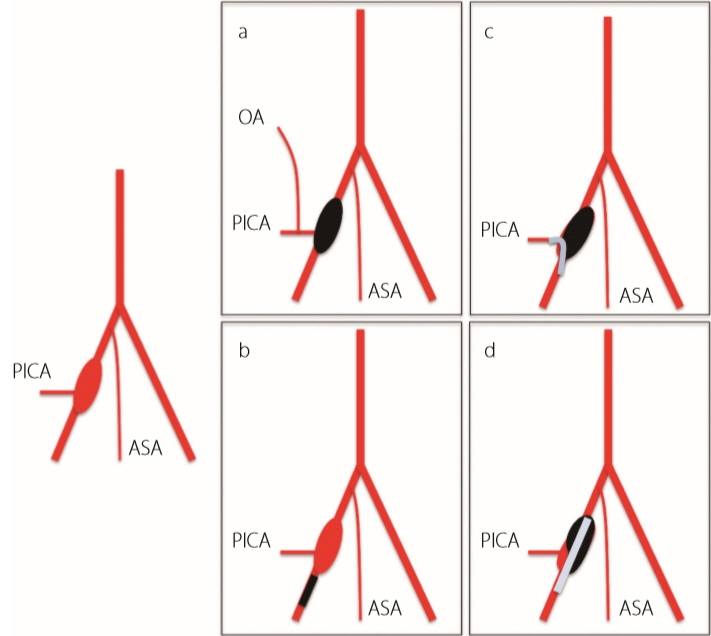Neurointervention.
2020 Jul;15(2):84-88. 10.5469/neuroint.2019.00276.
Stent-Jack Technique for Ruptured Vertebral Artery Dissecting Aneurysm Involving the Origin of Posterior Inferior Cerebellar Artery
- Affiliations
-
- 1Department of Neurosurgery, Tsukuba Medical Center Hospital, Tsukuba, Japan
- 2Department of Radiology, Tsukuba Medical Center Hospital, Tsukuba, Japan
- KMID: 2503394
- DOI: http://doi.org/10.5469/neuroint.2019.00276
Abstract
- We herein report a case of a ruptured vertebral artery dissecting aneurysm involving the origin of the posterior inferior cerebellar artery that was treated using the stent-jack technique. After parent artery occlusion of the distal vertebral artery, stenting of the posterior inferior cerebellar artery was performed. Further coiling was needed because distal vertebral artery recanalization occurred due to transformation of the coil mass. The stent-jack technique for a ruptured vertebral artery dissecting aneurysm involving the origin of the posterior inferior cerebellar artery is effective; however, careful attention to recanalization after stenting is needed due to transformation of the coil mass.
Figure
Reference
-
1. de Paula Lucas C, Piotin M, Spelle L, Moret J. Stent-jack technique in stent-assisted coiling of wide-neck aneurysms. Neurosurgery. 2008; 62(5 Suppl 2):ONS414–416. discussion ONS416-417.2. Yamada M, Kitahara T, Kurata A, Fujii K, Miyasaka Y. Intracranial vertebral artery dissection with subarachnoid hemorrhage: clinical characteristics and outcomes in conservatively treated patients. J Neurosurg. 2004; 101:25–30.
Article3. Mizutani T, Aruga T, Kirino T, Miki Y, Saito I, Tsuchida T. Recurrent subarachnoid hemorrhage from untreated ruptured vertebrobasilar dissecting aneurysms. Neurosurgery. 1995; 36:905–911. discussion 912-913.
Article4. Guan J, Li G, Kong X, He C, Long J, Qin H, et al. Endovascular treatment for ruptured and unruptured vertebral artery dissecting aneurysms: a meta-analysis. J Neurointerv Surg. 2017; 9:558–563.
Article5. Ahn JY, Han IB, Kim TG, Yoon PH, Lee YJ, Lee BH, et al. Endovascular treatment of intracranial vertebral artery dissections with stent placement or stent-assisted coiling. AJNR Am J Neuroradiol. 2006; 27:1514–1520.6. Satow T, Ishii D, Iihara K, Sakai N; JR-NET study group. Endovascular treatment for ruptured vertebral artery dissecting aneurysms: results from Japanese Registry of Neuroendovascular Therapy (JR-NET) 1 and 2. Neurol Med Chir (Tokyo). 2014; 54:98–106.
Article7. Iihara K, Sakai N, Murao K, Sakai H, Higashi T, Kogure S, et al. Dissecting aneurysms of the vertebral artery: a management strategy. J Neurosurg. 2002; 97:259–267.
Article8. Cho DY, Choi JH, Kim BS, Shin YS. Comparison of clinical and radiologic outcomes of diverse endovascular treatments in vertebral artery dissecting aneurysm involving the origin of PICA. World Neurosurg. 2019; 121:e22–e31.
Article9. Nakamura H, Fujinaka T, Nishida T, Kishima H, Sakai N; JR-NET3 study group. Endovascular therapy for ruptured vertebral artery dissecting aneurysms: results from nationwide, retrospective, multi-center registries in Japan (JR-NET3). Neurol Med Chir (Tokyo). 2019; 59:10–18.
Article10. Chen JA, Garrett MC, Mlikotic A, Ausman JI. Treatment of intracranial vertebral artery dissecting aneurysms involving the posterior inferior cerebellar artery origin. Surg Neurol Int. 2019; 10:116.
Article11. Ryu CW, Park S, Shin HS, Koh JS. Complications in stent-assisted endovascular therapy of ruptured intracranial aneurysms and relevance to antiplatelet administration: a systematic review. AJNR Am J Neuroradiol. 2015; 36:1682–1688.
Article12. Turk AS, Ahmed A, Niemann DB, Aagaard-Kienitz B, Brooks N, Levine RL. Utilization of self-expanding stents in the treatment of intracranial atherosclerotic disease in the distal small cerebral vessels. Neuroradiology. 2007; 49:659–663.
Article13. Siddiqui MA, J Bhattacharya J, Lindsay KW, Jenkins S. Horizontal stent-assisted coil embolisation of wide-necked intracranial aneurysms with the Enterprise stent--a case series with early angiographic follow-up. Neuroradiology. 2009; 51:411–418.
Article14. Chung J, Kim BS, Lee D, Kim TH, Shin YS. Vertebral artery occlusion with vertebral artery-to-posterior inferior cerebellar artery stenting for preservation of the PICA in treating ruptured vertebral artery dissection. Acta Neurochir (Wien). 2010; 152:1489–1492.
Article15. Ota T, Sato M, Amano T, Saito A, Matsumaru Y. Reconstructive endovascular treatment of ruptured vertebral artery dissection involving the posterior inferior cerebellar artery. Acta Neurochir (Wien). 2016; 158:1089–1093.
Article16. Phatouros CC, Sasaki TY, Higashida RT, Malek AM, Meyers PM, Dowd CF, et al. Stent-supported coil embolization: the treatment of fusiform and wide-neck aneurysms and pseudoaneurysms. Neurosurgery. 2000; 47:107–113. discussion 113-115.
Article17. Kim BM, Shin YS, Kim SH, Suh SH, Ihn YK, Kim DI, et al. Incidence and risk factors of recurrence after endovascular treatment of intracranial vertebrobasilar dissecting aneurysms. Stroke. 2011; 42:2425–2430.
Article18. Xu N, Meng H, Liu T, Feng Y, Qi Y, Zhang D, et al. Stent-jailing technique reduces aneurysm recurrence more than stent-jack technique by causing less mechanical forces and angiogenesis and inhibiting TGF-β/Smad2,3,4 signaling pathway in intracranial aneurysm patients. Front Physiol. 2019; 9:1862.
Article19. Kim BM, Kim DJ, Kim DI. Stent application for the treatment of cerebral aneurysms. Neurointervention. 2011; 6:53–70.
Article
- Full Text Links
- Actions
-
Cited
- CITED
-
- Close
- Share
- Similar articles
-
- The Dissecting Aneurysm of the Posterior Inferior Cerebellar Artery with Unusual Clinical Course
- Dissecting Aneurysm Associated with a Double Origin of the Posterior Inferior Cerebellar Artery Causing Subarachnoid Hemorrhage
- Antegrade Recanalization of Parent Artery after Internal Trapping of Ruptured Vertebral Artery Dissecting Aneurysm
- Isolated Dissecting Posterior Inferior Cerebellar Artery Aneurysm
- Flow diversion via telescoping stent with Low-profile Visualized Intraluminal Support Junior for treatment of ruptured dissecting aneurysm located at proximal posterior inferior cerebellar artery



